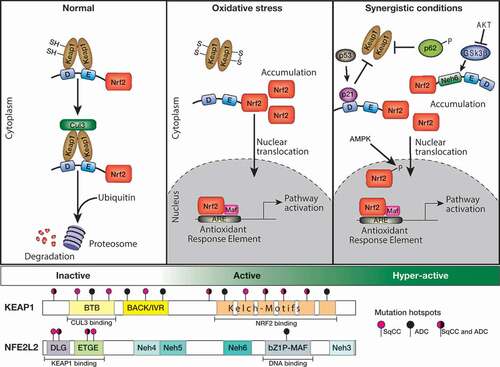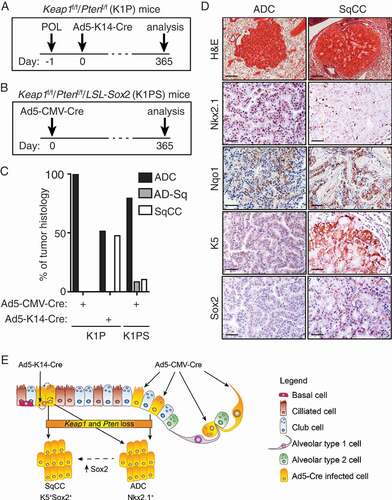(A) Timeline of polidocanol (POL) administration and adenovirus infection in
Keap1f/f/
Ptenf/f mice. Briefly, mice were intra-tracheally (i.t.) injected with 10 µl of 2% w/v polidocanol (POL) one day prior to intra-nasal infection of Ad5-K14-Cre virus. Mice were sacrificed, and lung tissue analyzed 12 months following adenoviral infection. (B) Timeline of Ad5-CMV-Cre virus infection in
Keap1f/f/
Ptenf/f/
LSL-Sox2 (K1PS) mice. (C) Quantification of histological phenotype of lung tumors in Ad5-CMV-Cre-infected
Keap1f/f/
Ptenf/f (K1P) mice [
Citation6] (n = 6), Ad5-K14-Cre-infected K1P mice (n = 5) and Ad5-CMV-Cre-infected K1PS mice (n = 3). (D) Representative Hematoxylin & Eosin (H&E) and immunostained sections of lung ADC and SqCC tumors detected in
Keap1f/f/
Ptenf/f mice 12 months following Ad5-K14-Cre infection. Scale bars; H&E-stained sections 200 µM; Nkx2.1, Nqo1, K5 and Sox2 50 µM. (E) Schematic representation of the consquences of combined loss of
Keap1 and
Pten in distinct cell types or when combined with enforced Sox2 expression. Combined loss of
Keap1 and
Pten in bronchiolar and/or alveolar type 2 (AT2) epithelium results in the formation of ADC tumors, while restricted loss of
Keap1 and
Pten to basal progenitor cells promotes SqCC formation. Interestingly, overexpression of Sox2 in K1P mice promoted the ADC to SqCC transdifferentiation, likely initiated from a “switched” Club or AT2 cell.


